Shatner Day 2011
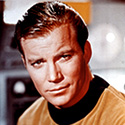
Details:
Date: Saturday, March 19, 2011
Length: No set length
Type: Multiple series
Format: Open schedule
Press Kit:
Movie Day Press Kit
Releases:
• March 24, 2011.
Last Saturday's fourth annual Shatner Day went well, fitting in a pair of classic movies and a trio of original Star Trek episodes with Charles, Dan, Katie, and Felicity along for the ride. While there isn't a specific rule that says that Shatner Day has to involve watching Shatner films, it's still nice to fit his work into the mix anyway. And hey! This had the upside of nudging along our long ignored Star Trek Marathon from 2009! Two days in one!
Things To Come (1936)
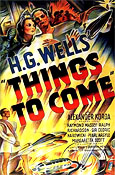 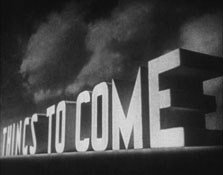
First up on the schedule was William Cameron Menzies' and H.G. Wells' Things to Come (1936). Wells had seen Fritz Lang's Metropolis (1927) and absolutely hated it. In a disparaging editorial Wells opined:
It gives in one eddying concentration almost every possible foolishness, cliché, platitude and muddlement about mechanical progress and progress in general served up with a sauce of sentimentality all its own ... Where nobody has imagined for them, the authors have simply fallen back on contemporary things ... The waste of it! I quote author Christopher Freyling in his book, "Mad, Bad and Dangerous? The Scientist and the Cinema":
Sure, in utopias and dystopias the unfamiliar had always been extrapolated from the known, but in Metropolis the known had not even been questioned let alone criticized. Wells did not like 'ultra-skyscrapers' and a city sectored into box-like workers' dwellings (down below), the consumer base (street level) and Rococo pleasure gardens for the bosses (up above); he did not like zombie-like ranks of operatives shuffling to work in shifts of ten hours, and the projection of mid-1920s labour disputes into the future ('the hopeless drudge stage ... will lie behind us', he said); and he did not like the bustle and chaos of contemporary New York night life writ large in a story purporting to take place in the future. Above all, he did not like Rotwang and his great experiment, which to Wells was 'the crowning moment of imbecility in the film': 'that soulless mechanical monster of Mary Shelley's, who has gathered so many German inventions, breeds once more in this confusion....' (Freyling 76-77) Though unspoken on screen, Metropolis is set in the year 2026, ninety-nine years following its original release. That distant future is now only fifteen years hence and Wells' anger over Lang's bleak outlook has perhaps not stood the test of time. According to Wells' complaints about Metropolis, the Twenty-First Century would not see the upper, ruling class projected to great riches and prosperity far above the wretched workers (a certain amount of literary metaphor to place them either above or below ground to drive the point). Gone too would be any sign of labor dispute, where the workers would be forced to stand in protest against an overwhelming, though considerably smaller in population, upper class. Complete fantasy! Wait. What?
Moreover, Wells' aversion to "ultra-skyscrapers" strikes me as preposterous. He published his novel, The Shape of Things to Come (on which the film was based with Wells himself penning the screenplay) in 1933, only two years after the Empire State Building opened in New York City. Topping out at 1,250 feet (1,454 if you count the radio antenna/airship mooring mast on the roof), the Empire State Building shouldn't have been a sign that this was the absolute apex of all upwards construction. In fact, the Empire State Building towered over the second tallest building in the world, the Chrysler Building located only eight blocks away, by 203 feet, and it had only been completed a year before the Empire State. Granted, it took another forty-one years for the Empire State Building itself to be bested by the World Trade Center with its North Tower standing 1,368 feet tall, but since then skyscrapers have only been growing, with the current tallest opening just last year in Dubai. The Burj Khalifa stands at 2,717 feet, more than twice as tall as the Empire State. Is a building more than half a mile in height not "ultra" enough? Wells, who died in 1946, couldn't possibly have known this, but at the very least he shouldn't have doubted it.
And of course, as long as we're speaking of New York, Wells predicted that its vibrant nightlife would be gone, replaced by ... what? He didn't specify, but the denizens of his own future city might have enjoyed a nice poetry reading.
As for Things to Come, Wells' great riposte to Lang, well ... it kind of bombed at the box office. I would imagine that viewers in 1936 didn't really appreciate a film that foreshadowed another world war -- a war already weighing heavily on everybody's mind in 1936 -- much less a film that depicts that very war waging until 1970, leaving all of humanity fractured and their technology crippled in its wake. A hugely devastating thirty-year global war probably wasn't the way to win the hearts and minds of theater-goers during the Thirties.
Today it possibly stands up better, the six years of World War II long behind us (though the potential for extremely fast civilization-destroying weaponry all too real). Things to Come tells an interesting enough story, of a civilization ruined by war only to be rebuilt as a kind of pacifist paradise below ground, and its design aesthetic laid the groundwork for so much of the science fiction that was to follow, especially by the sci-fi revival of the 1950s. Unfortunately the film is somewhat clunky, seeming like two separate short films in one (War and Postwar), and the characterizations perhaps a bit too exaggerated (especially Ralph Richardson's booming bravado as The Boss and Raymond Massey's intellectual earnestness as John Cabal).
Possibly most damning is that Things to Come, more so than Metropolis ever did, succumbs to that "sauce of sentimentality" that Wells criticized Lang of in his editorial. In Wells' vision, all of humanity joins together under the noble causes of "Research, Invention, World Planning, and Scientific Control" in a great progressive endeavour to build a better society. This they do, by 2036 adopting an appreciation of science and logic (save for a few naysayers who cannot abide the construction of a space gun to launch humans into the universe), all the while living in their gigantic underground cities, free of war, class, and struggle. "Sauce of sentimentality" indeed! And this is all from the same man who wrote a book about humanity in the far future breaking into two separate species: one of witless innocents who frolic above ground and one of savage cannibals who live below coming up only at night to prey upon the weaker ground-dwellers. Even Lang's "soulless mechanical monster" wasn't that cruel.
With this film Wells realized, at age seventy, that maybe filmmaking wasn't his forte. Fair enough. Everything is worth trying once. Nonetheless Things to Come is worth seeing and holds its own today, especially if one doesn't try too hard to compare it with Lang's completely different film despite Wells' own efforts to make that very connection.
My rating:     
(I don't want to give the impression that I dislike H.G. Wells. Far from it, I consider him one of the best science fiction authors of all time, and the worlds and times he imagined can still amaze and inspire today. I simply feel that he was wrong in his criticisms of Metropolis -- not because of whatever merits that Metropolis may possess but because his complaints were shallow and, perhaps, ridiculous. While Things to Come isn't a perfect movie it's far from being a bad one. I simply wonder if more could have been done to make it better if Wells hadn't invested so much effort into trying to outdo Metropolis and instead applied his great talent into coming up with a truly individual and unique story. Wells even seems to have recognized this fault when all was said and done.)
(Also, why is it that everything I write about Metropolis winds up turning into an essay?)
Star Trek: "The Menagerie" (1966)
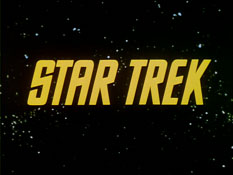 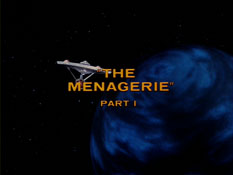 
In 1964 Gene Roddenberry and his team at Desilu Studios put together the pilot episode for a new series that he was calling Star Trek. This pilot, called "The Cage," detailed the adventures of Captain Christopher Pike and the daring-do crew of the starship Enterprise as they explored the mysteries of the universe. Submitting his finished episode for approval, Roddenberry was dismayed when NBC rejected it in February 1965, citing that its story was "too cerebral."
Roddenberry, a staunch Humanist who believed that people were more clever than they were given credit for, was no doubt discouraged by this description as NBC was essentially telling him to dumb down his work for the audience. Still, they must have seen something worthwhile in "The Cage" because NBC did the unthinkable: they commissioned a second try and proceeded to accept the series based on a second pilot, "Where No Man Has Gone Before," which substituted more fisticuffs and action for "The Cage's" talky philosophy. It also recast the lead when Jeffrey Hunter, who had portrayed Pike in the first pilot, decided not to return for the revamped show, paving the way for the entrance of a young William Shatner to be cast as Pike's successor, Captain James T. Kirk.
The series entered production with the new styling and the reworked show immediately found success on NBC. Yet they still had that entire unaired first pilot episode sitting around. It wouldn't make any sense to just toss it into the lineup, even in those days of giving little consideration toward continuity, and it seemed a waste to just leave it sitting in a vault. Enter "The Menagerie," the Original Series' only two-part episode, which aired in November 1966. In a sense it serves as a followup to "The Cage" (followup only being an applicable term years later when "The Cage" was released on its own in 1988), while also serving to introduce the earlier episode in its own right.
In a way "The Menagerie" is more than a clip show, as it manages to show nearly 90% of "The Cage," essentially being watched by Kirk and Spock as evidence in the latter's court martial for staging a mutiny to deliver a severely injured Captain Pike to Talos IV, the planet featured in the pilot. Taken on its own "The Menagerie" is interesting to see the adventures of an earlier Enterprise crew. Watching it in the context of a series marathon after having seen "The Cage" can be a bit trying.
Luckily it's been twenty-three months since we'd watched "The Cage" on day one of our severely delayed Star Trek Marathon, which we kind of abandoned in May 2009. After all that time "The Cage" wasn't really as fresh in everybody's minds (minus mine, but I think I've watched "The Cage" a lot more than Katie, Felicity, Charles, and Dan have). With so much time passed, it was maybe a nice refresher to how the series began.
My rating (both parts):     
The Philadelphia Story (1940)
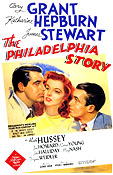 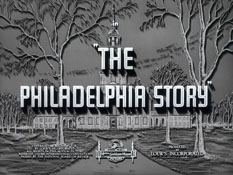
One brief subgenre of comedy during the 1930s and 40s was the Comedy of Remarriage. With the restrictive Hays Code of movie censorship in place, filmmakers were severely restricted in what they were able to get away with before being called out on grounds of indecency and immorality. The Comedy of Remarriage was one available avenue to get around the Code.
Basically it follows a simple formula. Step One, a couple gets divorced (bad enough as it is). Step Two, both parties are legally free to fool around with another partner (awful!); hijinks ensue when the original players are forced back into one another's lives due to comic circumstances. Step Three, the divorced couple realize that they can't live apart, discard their new partners, and remarry with renewed love. Moral crisis averted.
The Comedy of Remarriage is a spinoff of the Screwball Comedy genre pioneered by Frank Capra's It Happened One Night (1934). As such it shares many of the same traits. Typically, the female character is strong-willed and independent, and generally the one who leaves the man in the Comedy of Remarriage. The male character is usually the female's equal, if usually a notch below in terms of cleverness. He also tends to have some problem that drives away his wife, be it work, drink, or philandering. As such it becomes a moral story as the man cleans up his act, the woman stretches her legs and her wits, and in the end all is happily repaired with rejuvenated personalities who are better off going into their remarriage than they were the first time around.
George Cukor's The Philadelphia Story (1940) is a classic example of this format. Cary Grant and Katharine Hepburn divorce because Grant is a drunk, Hepburn becomes engaged to a terrible bore whom she can't relate to and proceeds to flirt with Jimmy Stewart, hijinks ensue, the wedding is called off, a recovered Grant and Hepburn remarry. Picture perfect, tied with a neat little bow, and Hays Code approved. But despite these predictably formulaic requirements, The Philadelphia Story fills its 112 minutes with interesting characters, screwball situations, and an excellent story where a vengeful Grant willingly helps two reporters (Stewart and Ruth Hussey) get a scoop on Hepburn's impending wedding, whose ceremony she was hoping would be free of any trashy tabloid journalists. At the same time he tries to blackmail her with a devastating story about her estranged father and a dancer. Hepburn relents to deal with him if she must.
Perhaps the only flaw with an otherwise impeccable film is that it maybe doesn't keep up same same levels of energy that other films in the genre manage. The first is also one of the best, 1937's The Awful Truth by Leo McCarey, pitting Grant (who appeared in most of the Comedies of Remarriage) against Irene Dunne as the divorced couple around whom the story revolves, with Ralph Bellamy as the new fiancé caught in the center. My all-time favorites of this type (and indeed, of all films from this era) is Howard Hawk's His Girl Friday, released in the same year as Philadelphia Story. His Girl Friday is a fast-moving comedy, full of rapid-fire witty dialogue between Grant and Rosalind Russell, one of the few actresses of her day who could go neck-and-neck with Grant in spitting out their lines, again with Bellamy as the new lover. It's a terrible shame that His Girl Friday was the only film in which Grant and Russell appeared together. It's sheer frenetic joy all around.
As one might imagine, there aren't a whole lot of films that fit the specific "Comedy of Remarriage" format and a lot of films that tend to be lumped under that header feature marriage but not specifically remarriage. The rest are just screwball comedies that happen to feature a wedding somewhere in the story. Bringing Up Baby (1938), for example, also with Grant and Hepburn, sees Grant as an paleontologist engaged to an unlikable fiancé when Hepburn catches his eye. Long story short, the fiancé gets the boot and Grant marries Hepburn (is that really a surprise?). Marriage but not remarriage.
So in a roundabout way, I highly recommend The Philadelphia Story, which stands as an excellent film, even if I think that there are funnier, faster, and more enjoyable entries that share its niche genre -- which isn't saying much since The Philadelpha Story is darn near perfect as it is.
Fun fact: The Philadelphia Story was remade as a musical in 1956 called High Society, staring Bing Crosby, Grace Kelly, Frank Sinatra, and ... Louis Armstrong. The Hays Code had relaxed by that time so the filmmakers didn't need to tiptoe around the subject matter quite as much as in 1940.
My rating:     
Star Trek: "Shore Leave" (1966)
 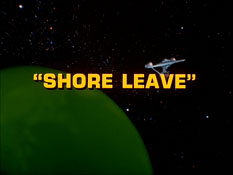
Felicity left and we decided to finish up by watching one more episode of Star Trek, the next one in order being "Shore Leave." In this one the Enterprise stumbles upon a very nice planet to take a well-deserved break. Only the planet manifests your thoughts into reality and that reality has a tendency of wanting to try and kill you.
I get why this episode has a giant rabbit, a knight on horseback, a yeoman in a medieval dress, and Kirk fighting an Irishman, but ... it never really worked for me. It's a fun episode, to be sure, but the whole setup feels contrived. I mean, even for a Star Trek episode.
Essentially, the Shore Leave Planet brings into reality whatever a person happened to be thinking wistfully of at the time. Dr. McCoy makes a connection to Alice in Wonderland and conjures up Alice and the White Rabbit. Yeoman Barrows imagines into existence Don Juan because ... I don't know? She's not getting any back on the ship? And of course Kirk would create someone to bang and someone to fight. Those are his two key character traits.
But I guess I don't really see Sulu walking around, daydreaming about a gun. And not just any gun but a .38 Police Special in particular. We know he gets drunk and tries to fence people but there's never been any indication before or since that he's a vintage gun enthusiast. Just came out of nowhere. Another crewman thinks of World War II fighter planes so the director could make use of some stock footage. There's also a tiger for some reason.
So, the episode definitely had a good idea, I can really see it working. I just don't think the writers took the individual characters into account and, perhaps an important flaw, peopled the landing party with a bunch of guest characters that we've never seen before and know nothing about. When the Shore Leave Planet reaches into their minds and brings their thoughts to reality, we have no frame of reference in which to say "that's why that character thought of that." With Kirk it makes sense that he'd dream up an old girlfriend. But we just don't know Barrows well enough to appreciate why she daydreamed into being a literary figure to sex her up something rude. On second thought maybe we don't want to know.
My rating:     
So that was Shatner Day 2011! All around a good time and a productive evening.
* * * * *
Source:
Freyling, Christopher. Mad, Bad and Dangerous? The Scientist and the Cinema. (London: Reaktion Books, 2005.)
• March 16, 2011.
Join us this Saturday, March 19 for Shatner Day (observed)! It is an early celebration for William Shatner's birthday, which actually falls on next Tuesday but, like, who has movie days on a Tuesday anyhow? No, it must be on Saturday because that is the day when anything goes.
Feel free to show up for who knows what! Don't hesitate to bring movies of your liking with you, 'cause we're all for variety and the mighty Shatner cares not for preordained schedules. We'll be starting at 3:00.
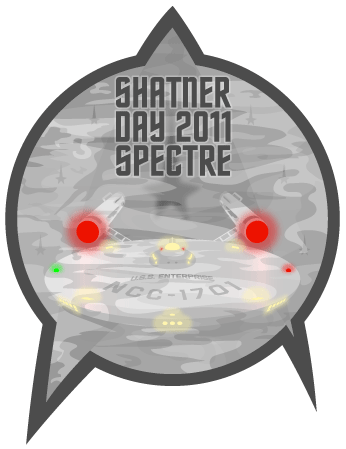
(Click for larger)
DISCLAIMER: Just because we're celebrating Shatner doesn't mean we're going to watch Star Trek. Don't worry.
ABOUT SHATNER DAY
Shatner Day is usually the first major movie day after the new year. Traditionally the first two and a half months are given over to half-hearted events without much planning, inviting, or effort. In 2009, there was nothing at all between January 10 and Shatner Day. This is a day that marks the beginning of spring and, with it, the new movie day season that usually extends up to around JoshFest, when things peter out again.
Previous Shatner Days: 2008 | 2009 | 2010
|













